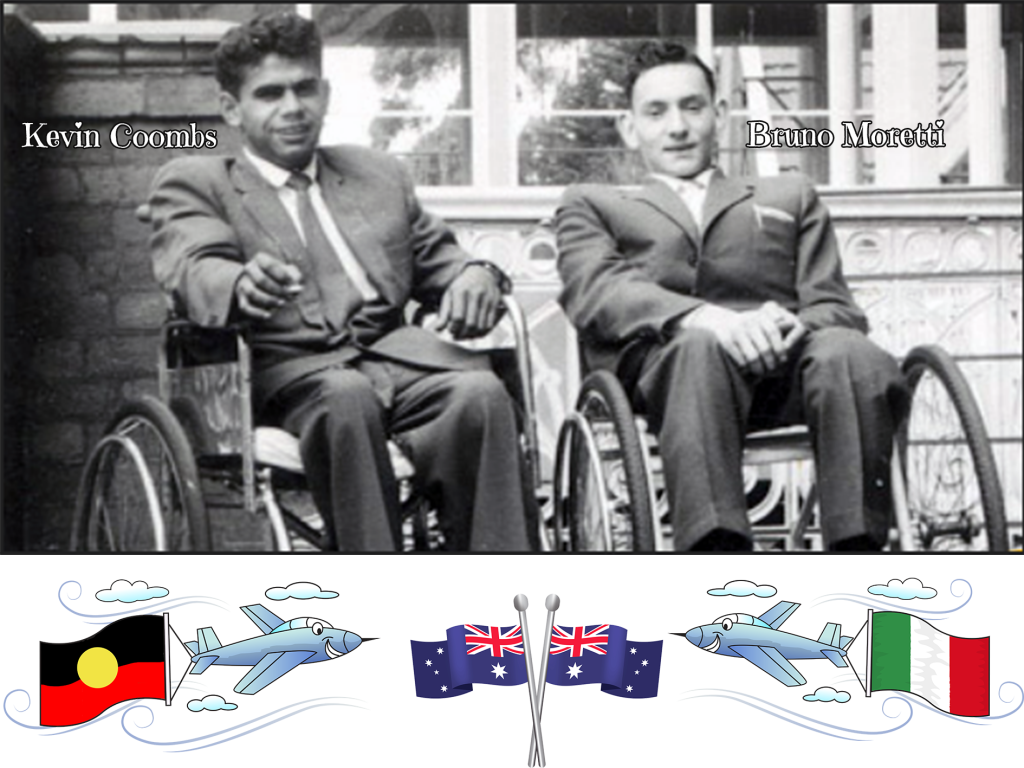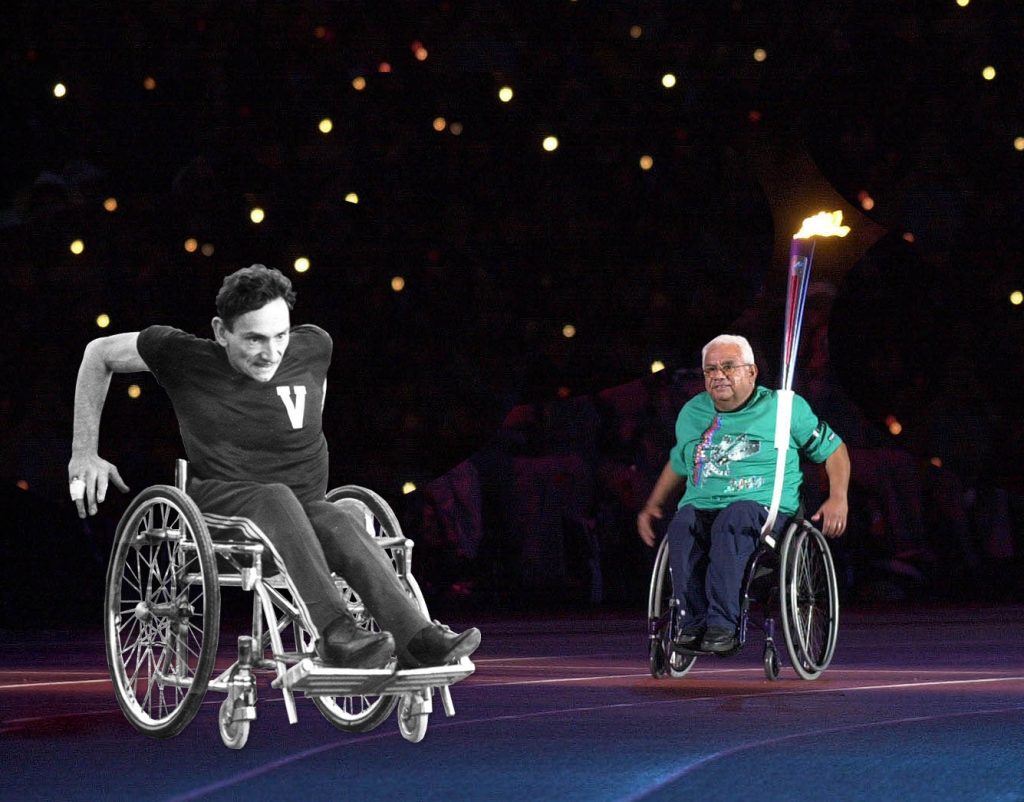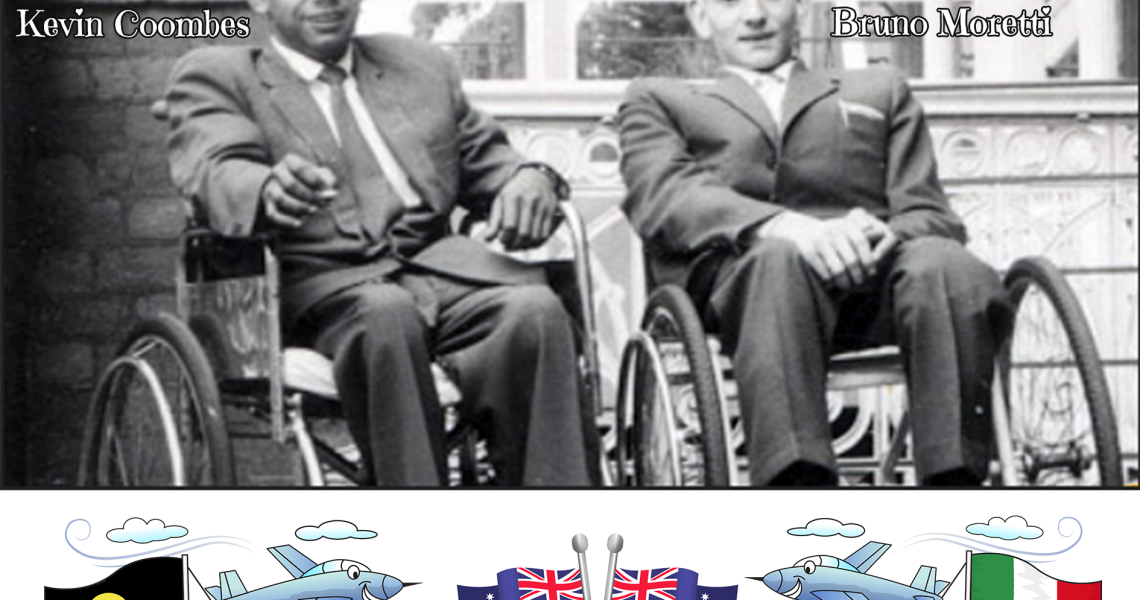Two with mobility condition of paraplegia. One got much more due to his “disadvantaged” ‘Aboriginal’ socially constructed race heritage

The two men in the photos in this blog are Kevin Coombs and Bruno Secondo Moretti. Both were born in Australia in 1941. Both obtained the physical mobility impairment of paraplegia before adulthood. Both came from non-English cultural heritage. Bruno’s parents had immigrated from Italy and English was a second spoken language by Bruno.
Bruno Moretti deserved to be recognised in a way that he was not. Instead, modern society sent him to the back of the room because he did not have the socially constructed Aboriginal race heritage that Kevin Coombs had.
Bruno, a paraplegic since birth, did not qualify for the National Disability Insurance Scheme due to his age and a few years ago he devised a handmade accelerator / brake control to drive his car as there was no government funding assistance for him to buy a professionally made hand control.
Around the middle 1970’s Bruno was my basketball coach for some years. At a wheelchair basketball presentation ball in June 1976 he introduced me to my husband, Antonio Rigoni. We did not have a close social relationship with Bruno. Over the years we would catch up here or there. I last saw Bruno when we had a coffee catch up in Greensborough in between COVID lockdowns. He looked fit and healthy and was still attending local markets selling his home crafted wood pens. I was surprised when my aunty Gail told me that she had read his death notice in the paper. Bruno died on 1 November 2021.
I met Kevin Coombs when he played wheelchair basketball in an opposing team, in the same competition my husband Tony, played alongside Bruno Moretti. I have not seen Kevin face to face since Tony stopped playing wheelchair basketball in 1979.
When young, Bruno and Kevin were pitied by many in society who considered their accidents grievously unfortunate. Society did not know how to look after paraplegics very well back then. As they left boyhood behind they experienced the beginning of great changes in the treatment, rehabilitation and opportunities available for those living with severe spinal damage no matter what your ancestry line was. One of the first things that they were taught was the purpose of the gymnasium was that they had to be able to lift their own body weight because that was their means of independence.
Bruno Moretti and Kevin Coombs were both highly respected elite athletes, friendly, and approachable men and they were liked by most people. Bruno was defined as one of the “most revered pioneers” of the Australian Paralympic Movement. Kevin was and is defined by his ‘aboriginal race’ ancestry and the success and material gain and kudos that heritage has given him and his family.
In 1962, the ParaVics Sports Club was founded by Bruno Moretti, Kevin Coombs, and a few others to help a group of eight athletes with ‘disability’ compete in national and international sporting competitions.
Both men were unable to move their legs, stand, or walk without mobility aids. As ‘Incurables’. Kevin used a wheelchair full time. Bruno used callipers and crutches as much as he could and used his wheelchair as a backup mobility aid. Both had paraplegia as a result of accidents which damaged their spinal cord.
Both men married. Kevin married Linda in 1969 and had two daughters. Bruno married Scarlette and had one son in the 1980’s.
Bruno had his back accidently damaged during his birth delivery in 1941.
Kevin was accidently shot at the age of 12 years by his 9 year old cousin.
Bruno was delivered as the unexpected second born twin. A medical mishap occurred during the birth delivery and his spine was damaged at Airlie Hospital in Ivanhoe. Bruno mostly grew up living at home with his immigrant Italian family in Kew where until age 14 he was under the care of the Royal Children’s Hospital. There were no wheelchairs around when he was young and his parents would push him around in a trolley. Or he would drag himself around pulling himself along the ground with his arms, dragging his legs behind him.
Between the age of five and seven Bruno was an inpatient at the Children’s Orthopaedic Hospital in Mt Eliza, basically stuck in bed 24/7. He went there not being able to speak a word of English and came home not being able to speak a word of Italian. He saw very little of his mother, father, or twin brother during this period of his life.
Bruno attended St. Anne’s primary school in Kew then was moved to East Kew Central where there were a lot of stairs that his brother used to piggy back him up and down. At age 14 he obtained a chain driven wooden wheelchair and got a job selling newspapers in front of the Harp of Erin Hotel.
As a 15 year old Bruno’s care was the responsibility of the Austin Hospital’s Spinal Unit. An examination by Dr Ludwig Guttmann, a German neurologist visiting from England, revealed a diagnosis of ‘incomplete’ paraplegia which confirmed that the Austin Hospital Spinal Unit was the most appropriate place to care for Bruno and assist in his rehabilitation in preparation to live an independent adult lifestyle. Within months of being at the Austin staff had noted Bruno was ‘mobile walking on crutches’ and ‘motoring around’.
Being able to walk using a calliper came about after Bruno went though a series of sessions where weights and casts were placed on his left leg to straighten it. Eventually with one straight leg in a calliper using crutches he could carry himself around in an upright stance. He usually only used his wheelchair for sport and when he was moving around the ward. Being upright allowed Bruno much more mobility than full time wheelchair users.
Kevin Coombs was born on the 30 May 1941, in Swan Hill, Victoria. His mother died when he was five and he moved to Balranald in New South Wales to live with extended family. On the 4 September 1953 while enjoying the school holidays sitting on the Murrumbidgee river bank he became a paraplegic as a result of a bullet discharged from a loaded gun that was fired three feet away from him. At the time he was out with some family members hunting rabbits to sell . After the shooting an uncle rushed him to Swan Hill hospital where surgeons operated on him and saved his life. The bullet wound was so severe his life expectancy was a month or so.
After about 12 months with bad bedsores Kevin was transferred to the Royal Children’s Hospital in Melbourne where he stayed on his stomach for 12 months recovering. He did not see his family for a couple of years.
In his book, A Fortunate Accident, published in 2005 Kevin claims “There has always been someone there ready and willing to give me a lift.”
In 1957 when Bruno Moretti and Kevin Coombs were inpatients at the newly established Austin Hospital spinal unit they used to play sport in their wheelchair as a recreation. This was a part of the getting back into society regime.
Both men displayed outstanding sporting ability and were founding members of the ParaVics Sports Club Victoria in 1962 and both men were in the Australian Paralympic Team competing in the inaugural Paralympics Summer games in Rome in 1960.
Both men represented Australia in the 1968 Paralympic games in Tel Aviv.
At these two Paralympic games Kevin’s medal tally was 0, Bruno won one Gold medal and 3three Silver medals in table tennis and athletics. In fact although competing in five paralympic games Kevin never won a Paralympic medal.
Kevin won one silver medal and Bruno won five gold medals in weightlifting, table tennis, basketball and athletics representing Australia at Commonwealth games.
Kevin captained the Australian Paralympic wheelchair basketball team on several occasions and the whole Australian Paralympic Team at one of the Paralympic games. He played in the wheelchair basketball team in five Paralympic games during the 1960’s and 1970’s.
Bruno won the award for ‘Best Male Athlete’ at the 1970 Australian Paraplegic Games. Kevin won Australian Basketballer of the Year a couple of times and has stated ‘He was the best!’.
Bruno coached the Australian Wheelchair team and the Australian Rugby team and a variety of able body basketball teams at various times. He was a successful coach who had quadriplegics’ doing stuff they weren’t supposed to be able to do. A motto of his was “If you ain’t going to push the envelope you ain’t going anywhere”. His coaching helped to get the wheelchair basketball team from B grade to A grade competition. In 1992 he took the ‘murder ball’ Rugby team to Canada. He wanted the team players competing for Australia to be recognised as sports people not ‘disabled’ people.
Amongst other things Kevin has received a medal of the Order of Australia, had a Sydney Olympic Park street named after him, was inducted into the Australian Basketball Hall of Fame, had a Victorian government meeting room named after him, was inducted into the Australian Paralympic Hall of Fame, had the head office of Disability Sport & Recreation (ParaVics) in Fitzroy named after him, had the Australian Junior Wheelchair Basketball Championships named in his honour.
Kevin did not know who nominated him for the Order of Australia Medal in 1983 awarded in recognition of service to sport for the disabled and Aboriginal welfare.
At the 2000 Paralympics in Sydney, Kevin was a torch bearer and according to his wife, Linda, they were treated like royalty during the whole event. Bruno on the other hand received an invitation to the closing ceremony.

Of the 12 athletes who attended the first Paralympics Games held in Rome in 1960, eight were still alive 50 years later. Seven of the original team including Bruno Moretti and Kevin Coombs were able to attend a 50 year anniversary reunion held in Sydney.
Kevin was invited to work for the government in Aboriginal Affairs and was employed as a public servant for over 21 years. Kevin had his autobiography published via government funding. Kevin was offered public housing. During his time as a public servant he was aware that Aboriginal Race funding was provided by the Commonwealth government, the state government, and the non government Aboriginal Race sector. There were agreements between Aboriginal race organisations and the state government for quotas of Aboriginal race people to be employed in the public service.
Bruno a watchmaker by trade, worked for the Preston City Council repairing some of the most difficult timing designs of the day. Bruno Moretti did not like to be the ‘Hero’ and accepted many things, that maybe he should have challenged but his attitude was ‘that’s life… better get on with it!’.
Bruno Moretti was not offered the same housing or employment opportunities or given the same public recognition of his sporting achievements as Kevin Coombs was.
Both of these men had the same permanent mobility condition of paraplegia. One was provided more opportunity and public recognition because of his “disadvantaged” ‘Aboriginal’ socially constructed race label and not in spite of it.
